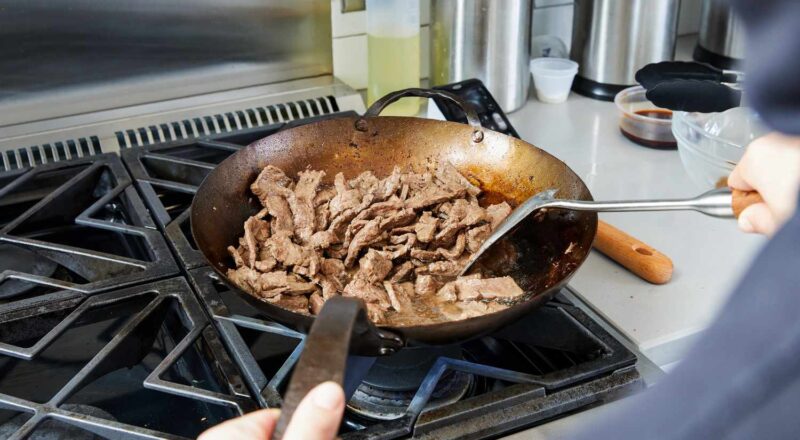The culinary world has long debated: which wok is the best for every kitchen enthusiast? A specialized tool with centuries of history, woks offer a unique cooking experience that can elevate the simplest of dishes to gastronomic delights. Whether you’re a novice cook or a seasoned chef, choosing the right wok is an essential step toward culinary excellence.

The Tremendous Journey of the Wok
The wok is a versatile cooking tool that has been adopted around the globe due to its effectiveness in preparing a wide range of dishes. From stir-frying to steaming, a wok offers possibilities that are only limited by the cook’s imagination.
Technology and Wok Crafting: What’s Changed?
Today’s woks come in a variety of materials and designs, reflecting advances in food technology and personal cooking preferences. The application of better materials and creative designs aims to make cooking with a wok an even more delightful experience.
Traditional vs. Modern Woks
Traditional woks are typically made of carbon steel, which heats quickly and evenly. Modern variants, however, often incorporate stainless steel, cast iron, or even non-stick surfaces for easy maintenance and safety.
Why Choose the Right Wok?
Selecting the best wok for your kitchen involves considering aspects such as cooking style, frequency of use, and even storage space. The right choice can enhance the taste and texture of your culinary creations.
Material Matters
The material of the wok plays a pivotal role in heat distribution and retention. Carbon steel woks, for example, are beloved for their ability to rapidly heat up, contributing to perfect-making techniques like stir-frying, while cast iron woks offer unmatched heat retention.
Exploring Wok Shapes and Sizes
Woks are traditionally round-bottomed or flat-bottomed, with the design affecting how the heat is distributed and how you handle the tool. Understanding these differences can vastly alter your cooking results.
Handles: Single or Dual?
The handle design is crucial for maneuverability. Woks featuring dual wooden or metal handles provide essential grip during high-heat cooking, while single long handles may favor lighter tasks.
Comparing Carbon Steel and Cast Iron Woks
There’s a consistent debate about these two popular types. Carbon steel is appreciated for its rapid heating properties, while cast iron excels in maintaining consistent heat levels.
Get grill marks like a pro using these guidelines and techniques.
Carbon Steel: Speed and Precision
When considering a carbon steel wok, the primary benefit is its quick heating ability. This feature is ideal for fast-paced stir-frying, allowing quick temperature adjustments during cooking.
Cast Iron: Steadiness and Flavor
Cast iron, in contrast, is all about even and steady heat distribution. Meals that require gentle cooking or prolonged simmering can benefit from the consistent heat it offers.
Size Matters in Wok Selection
Common sizes range from 10 to 16 inches, empowering cooks with various options based on family size and types of meals prepared. A larger wok supports larger dishes and gatherings.
A Family Choice: Large Woks
For family meals or gatherings, large woks can easily accommodate multiple servings, making them efficient for communal dining.
Handle the Heat: Wood vs. Metal
The handle material affects both comfort and safety in cooking. Wooden handles are cooler to the touch, whereas metal ones may require protective handling.
Safety and Pragmatism
When choosing the handle type, consider your own comfort, hand strength, and tolerance to heat. Both handle types have their own benefits and applications.
Choosing a Non-Stick Wok: Beneficial or Not?
Non-stick coatings can simplify the cooking and cleaning process, yet they may not yield the same flavor depth as traditional material woks.
Convenience Comes at a Cost
While easier to clean, non-stick surfaces require specific utensils to prevent scratching, which adds an extra step to the cooking process.
Balancing Aesthetics and Functionality
The wok can be as much a visual asset in the kitchen as a functional one, with some designs emphasizing artistic appeal alongside culinary utility.
Stylish Wok Options
Modern designs offer aesthetic choices to match kitchen decor, providing style without compromising on performance.
Terrific Alternatives to Traditional Models
If a traditional wok isn’t appealing, consider electric models for precision cooking or multi-layered pans for enhanced flavor exploration.
This external guide explores wok cooking techniques that align with modern cooking preferences.
Electric Woks: Precise and Convenient
Electric woks provide consistent heat control, making them suitable for those new to Asian cuisine or who seek more straightforward control over their cooking temperature.
FAQs on Using a Wok
What is the ideal material for a wok?
Carbon steel is often favored for its quick heating capabilities, while cast iron offers consistent heat retention, making both excellent options depending on cooking goals.
How do I maintain my wok’s condition?
Regular seasoning and proper cleaning are imperative to maintaining your wok’s condition. Check out this cleaning guide for tips.
Can non-stick woks be used for high-heat cooking?
While they can handle high heat, non-stick woks are generally best used under moderate temperatures to preserve their surface coating.

Conclusion: Find Your Perfect Wok
Answering ‘which wok is the best‘ involves understanding your cooking style, kitchen space, and culinary needs. From carbon steel to electric models, the wok choice is personal and varies with expectations. Invest wisely to take your child culinary efforts to the next level.
As an Amazon Associate, I earn from qualifying purchases.

